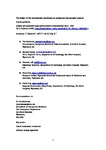The height of the cricothyroid membrane on computed tomography scans in trauma patients
| dc.contributor.author | Nutbeam, T | |
| dc.contributor.author | Clarke, R | |
| dc.contributor.author | Luff, T | |
| dc.contributor.author | Enki, Doyo Gragn | |
| dc.contributor.author | Gay, D | |
| dc.date.accessioned | 2017-06-30T11:28:18Z | |
| dc.date.issued | 2017-05-02 | |
| dc.identifier.issn | 0003-2409 | |
| dc.identifier.issn | 1365-2044 | |
| dc.identifier.uri | http://hdl.handle.net/10026.1/9570 | |
| dc.description.abstract |
<jats:title>Summary</jats:title><jats:p>Emergency cricothyrotomy is a common feature in all difficult airway algorithms. It is the final step following a ‘can't intubate, can't oxygenate’ scenario. It is rarely performed and has a significant failure rate. There is variation in the reported size of the cricothyroid membrane, especially across population groups. Procedural failure may result from attempting to pass a device with too large an external diameter through the cricothyroid membrane. We aimed to determine the maximum height of the cricothyroid membrane in a <jats:styled-content style="fixed-case">UK</jats:styled-content> trauma population. Electronic callipers were used to measure the maximum height of the cricothyroid membrane on 482 reformatted trauma computed tomography scans, 377 (78.2%) of which were in male patients. The mean (<jats:styled-content style="fixed-case">SD</jats:styled-content>) height of the cricothyroid membrane, as independently measured by two radiologists, was 7.89 (2.21) mm and 7.88 (2.22) mm in male patients, and 6.00 (1.76) mm and 5.92 (1.71) mm in female patients. The presence of concurrent tracheal intubation or cervical spine immobilisation was found not to have a significant effect on cricothyroid membrane height. The cricothyroid membrane height in the study population was much smaller than that previously reported. Practitioners encountering patients who may require an emergency surgical airway should be aware of these data. Rescue airway equipment with variety of external diameters should be immediately available.</jats:p> | |
| dc.format.extent | 987-992 | |
| dc.format.medium | Print-Electronic | |
| dc.language | en | |
| dc.language.iso | en | |
| dc.publisher | Wiley | |
| dc.subject | difficult airway algorithm | |
| dc.subject | failed intubation: treatment | |
| dc.title | The height of the cricothyroid membrane on computed tomography scans in trauma patients | |
| dc.type | journal-article | |
| dc.type | Journal Article | |
| plymouth.author-url | https://www.webofscience.com/api/gateway?GWVersion=2&SrcApp=PARTNER_APP&SrcAuth=LinksAMR&KeyUT=WOS:000405294600009&DestLinkType=FullRecord&DestApp=ALL_WOS&UsrCustomerID=11bb513d99f797142bcfeffcc58ea008 | |
| plymouth.issue | 8 | |
| plymouth.volume | 72 | |
| plymouth.publication-status | Published | |
| plymouth.journal | Anaesthesia | |
| dc.identifier.doi | 10.1111/anae.13905 | |
| plymouth.organisational-group | /Plymouth | |
| plymouth.organisational-group | /Plymouth/Faculty of Health | |
| plymouth.organisational-group | /Plymouth/REF 2021 Researchers by UoA | |
| plymouth.organisational-group | /Plymouth/REF 2021 Researchers by UoA/UoA03 Allied Health Professions, Dentistry, Nursing and Pharmacy | |
| plymouth.organisational-group | /Plymouth/Research Groups | |
| plymouth.organisational-group | /Plymouth/Research Groups/Institute of Health and Community | |
| plymouth.organisational-group | /Plymouth/Research Groups/Institute of Translational and Stratified Medicine (ITSMED) | |
| plymouth.organisational-group | /Plymouth/Research Groups/Institute of Translational and Stratified Medicine (ITSMED)/CBBB | |
| dc.publisher.place | England | |
| dcterms.dateAccepted | 2017-01-17 | |
| dc.rights.embargodate | 2018-5-2 | |
| dc.identifier.eissn | 1365-2044 | |
| dc.rights.embargoperiod | 12 months | |
| rioxxterms.versionofrecord | 10.1111/anae.13905 | |
| rioxxterms.licenseref.uri | http://www.rioxx.net/licenses/under-embargo-all-rights-reserved | |
| rioxxterms.licenseref.startdate | 2017-05-02 | |
| rioxxterms.type | Journal Article/Review |


